Politics of the European Union
1/214
There's no tags or description
Looks like no tags are added yet.
Name | Mastery | Learn | Test | Matching | Spaced |
|---|
No study sessions yet.
215 Terms
What is a theory
A simplifying device that allows you to decide which factors matter and which do not - Beylis
Grand theories
General/classic integration theory
Meso-theories
Mid-range theories
Developing theoretical approaches to explaining particular aspects of functioning of the EU
Examples of Grand theories for EU integration
Federalism
Functionalism
Neo-functionalism
Intergovernmentalism
Liberal intergovernmentalism
Federalism
federalist idea: preciously discreet, distinct or independent entities come together to form a new whole, in which they merge part of their autonomy
Two understanding:
Theoretical phenomenon
Political movement
1941: Manifesto di Ventotene by Spinelli and Rossi: ‘democratic radicalism’
1943: Foundation of the European Federalist movement
1946: Foundation of the European Union of Federalists
1952: Monnet & creation of ECSC: ‘federalism by installments’
Analytical approach: two levels of government, each at least with one autonomous sphere of decision-making
Functionalism
1943: David Mitrany’s A Woking Peace System
Started as critique to federalism:
Federalism = utopia
functionalism argues for creation of functional agencies and through them national divisions will become less important
Focus on role of states and intergovernmental agreements
Functional integrations characterized by:
Functionality
Pragmatism
Flexibility
Peace through a network of institutions dealing with non-controversial issues
Neofunctionalism
First theory of European integration in 1958 by Ernst B. Haas
Rational, self interested and flexible actors who learn from their experiences
National and supranational elites provide key impetus to integration
Membership of ECSC/EU changes the way in which national gov see their interests
Once established, the institutions take on ‘a life of their own’
Positive-sum game
functional spillover
Political spillover
Functional interdependence between economies of the member states will foster further integration
Neofunctionalism: functional spillover + example
Integration in one functional area will lead to integration in others
Example: internal market → social dimension → single currency → fiscal harmonization
Neofunctionalism: political spillover + example
National elites become favorably disposed towards integration process and consider common interests; supranational institutions and non-governmental actors become more influential while the states become less influential
Example: increase of the role of the Commission → increased use of the QMV voting in the Council → the role of the ECJ and its support for intergration
Neofunctionalism: critique
cannot provide a general theory of European integration, especially not the origins
Spillover is not automatic
Difficulties in explaining a slow-down in integration in 60s and 70s
Overly reliant on the role of actors/elites as opposed to structure
Does not adequately account for the broader international context
Neofunctionalism: summary
In spite of criticism, it has been an evolving theory and we hav even seen a recent revival in EU scholarship
Intergovernmentalism: realist and liberal
Explains integration through the actions and decisions taken by the governments of memebr states
Much of the critique of neo-functionalism came from intergovernmentalism
STATES on central stage
Roots in realist theories (neo-realism)
Main difference between intergovernmentalism and Neofunctionalism
Intergovernmentalism: states are key actors
Neofunctionalism: elites and NGOs are key actors
Liberal Intergovernmentalsim
3 main ideas
States are rational actors. They achieve their goals through bargaining rather than through a centralized authority making
Domestic politics matter, it shapes the state goals
Governments are key in relations between states and the relative bargaining power pre-determines the outcome of negotiations
National security is not the main motivation behind the state action
Lowest common denominator is often the outcome of negotiations
Lowest common denominator is the outcome when there are tough negotiations going one
The most ‘broad’ common policy, agreement etc they can agree on
Not always the case though!
Could be a critique of theory
Liberal intergovernmentalism: critique
the choice of ‘easy cases’
‘Easy cases’ = focus on history making cases like changing of treaties
Places where states, govs play key role
Also policies that are easier —> agriculture ex
Ignoring the informal decision-making
Insufficient attention to the different ways in which the governments choose their policy options
Underestimating the powers of Commission, the ECJ and the interest groups
Would be easier to withstand some of the criticism if they did not identify as a grand theory
If they were more niche and say they focus on specific policy areas, like agriculture, a lot of the criticism would not work anymore
Governance
The capacity to overcome collective action problems in ways that are agreed by the participants in the society f
Governance approaches
Not about explaining why states cooperate/integrate but about explaining how the EU worlds as a political system
Multi-level governance (MLG)
sovereignty of individual states is diluted in the European arena by collective decision-making and by supranational institutions
The locus of political control is changed
Focusing on the regional-level, national-level and Eu-level (supranational-level)
Multi-level governance (MLG): 3 main ideas
Decision-making competences are shared among actors at different levels: regional, national and European (not monopolized by the state)
There has been a significant loss of control for state executive
The political arenas are interconnected
Instead of being explicitly challenged, states in the EU are being melded gently into a multi-level polity
Feminist critique of integration theories
The theory itself is not new, but its voice in the conversation is rather new
Kronsell - did not think EU integration took gender into consideration seriously
Other theories fail to see how gender effects all kinds of areas within EU integration
Main point of view was male
Gender is main organizing principle of social relations + power asymmetry is the main focus
Feminist critique vs liberal intergovernmentalism
fails to recognise the power relationship between the state and the nation; gender relations become irrelevant, hence Liberal intergovernmentalism defines the place of politics as a place where women are not.
LI and feminist share power as basis HOWEVER see power very differently
Feminist critique vs Neofunctionalism
highlights the importance of interest groups, which for feminists may be an important mechanism for change. However, it pays no attention to dominance of certain groups over others.
Feminist critique vs MLG
shares some similarities with feminism in their views on power, which takes multiple forms and is constantly reshaped BUT could be more critical in patterns of authority that emerge from multi-level interactions.
De-centering and post-colonial approaches
Mostly connected to external relations of EU
Eurocentrism survived European imperialism
Eurocentrism is very present when we analyze EU integration and EU’s place in the world
Post-colonial perspectives have been omitted from the first wave of theorizing EU integration
Interpreting history and power relations
"marginalized a central historical fact: the role of appropriation of non-European resources and labour in the empowerment of European states through to at least the mid-20th century, the violence this entailed and the echoes - direct or indirect - of this European past among those former 'subjects' among whom are to be found the rising powers of today's world."
3 dimensions of decentering
Empirical | Normative | |
Provincializing | Question Eurocentric accounts of world history and politics | Question Eurocentric ‘civilizational’ assumptions |
Engaging | Engage others perspectives in which Europe may or may not figure | Engage others assumptions with a view to mutual engagement |
Reconstruction | Recognize historical patterns underpinning the EU’s external relations | Explore more ‘decentered’ approaches to the EU’s external relations on the basis of mutuality and empowerment |
Provincializing: taking Europe away from the center of analysis
Examples of EU external relations
involvement in Iran nuclear deal
Sanctions on Myanmar
Human rights in China
Statements on attacks against Israel
EU response to Russian aggression on Ukraine
In recent years this has been the main focus on EU foreign policy
For many years this was an issue that the EU member states was divided on
EU responded fast, strong and united
Something that was not expected
Remarkable
Overcoming business, financial, energy interests
Overcoming very different threat perceptions among member states ‘
EU’s role in world depending on policy
Economic giant
Political dwarf
Defense Pygmy
Difference between external relations and foreign policy
External relations is broader than foreign policy
It includes:
Development
Enlargement
Agriculture
Public health
Historically only states can have foreign policy, when EU was starting up it was hard for them to speak about EU foreign policy —> therefore external relations/actions
Language was adopted by many EU institutions
EU does not have monopoly of foreign policy making in Europe
How conducts foreign policy in EU?
“The EU is state-like but does not formally aspire to statehood. It may have a “foreign policy”, but it clearly lacks a monopoly on foreign policy-making in Europe. It thus seems to exist in a conceptual no mans land” - D. Allen
Does the EU speak with one voice outward?
Simple answer no, not really (but does on some specific areas)
There are a lot of voices in EU and they don’t always say the same thing when it comes to foreign policy —> councils, foreign ministers in the council, national ministers
Trade = EU speaks with one voice
Regulations = EU speaks with on voice
Currently there is no institution that has the mandate and legitimacy to speak with one voice for all of EU
Commission and Council President elected by EP or as far as the people of EU; that congregation would have mandate and legitimacy
EU: superpower?
Economy, population are up there but with other aspects they lack
Foreign minister: depends on the issue as to where the EU stands and how
Trade + development 👍
Defense 👎 (both agree on this)
EU lacks some strategic capacities for becoming a superpower
EU external action: 3 competences
intergovernmental
Shared competences
Exclusive competences
Tells us key actors that will be involved in decision making about the external action
EU external action: intergovernmental
most involvement from the member states —> in drivers seat
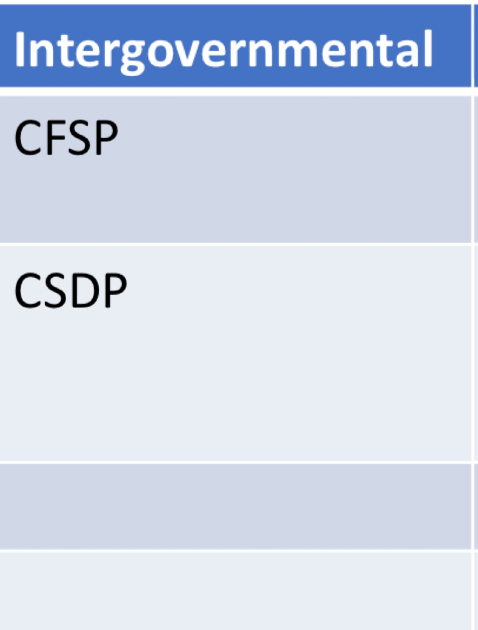
EU external action: shared competences
Will have a mix of actors involved
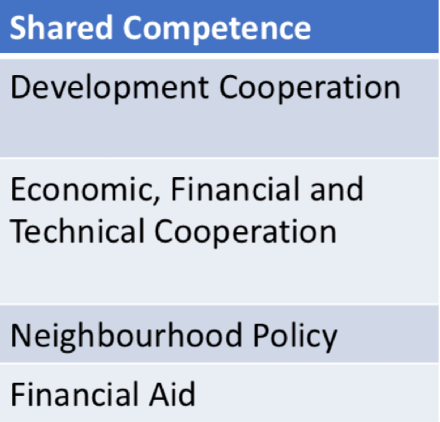
EU external action: exclusive competences
Trade will have a greater involvement of EU Commission

History: European Political Cooperation (EPC) before 70s
Predecessor of CFSP is EPC
Known for:
Flexibility
Confidentiality
Informality
Historically it all started with the EPC
Seen as second Europe (first Europe was the European Communities —> political cooperation kept separate)
First 17 years the political cooperation had no legal or even formal standing and no institutions/secretariat
Described as a secret club by diplomats for diplomats
They loved it —> confidential and informal
Small expectations —> when agreement was found it was a big surprise and big achievement
No journalists
No complicated procedures
Common foreign and Security Policy (CFSP)
Maastricht treaty: birth of CFSP
Separate pillar: institutional structure same but decision-making would be different and involvement of actors world be different
Unanimity and members in drivers seat
Defense provision cautious due to there being a split between members wanting or not wanting
We have NATO so we don’t need another one
Netherlands, UK
Some countries wanted to proceed faster but was made impossible by the ones that did not want to
France, Italy
Amsterdam treaty: to help with consistency
Through High Representative for CFSP
Did not have a lot of power —> was about coordination
Today they have a lot more power
Javier Solana was the first one (1999)
Changes the Treaty of Lisbon brought
CONSISTENCY is the key word
Union acquires legal personality (art. 46A)
Pillar structure disappears
New Permanent President of the European Council (art 9B.6)
“High Representative for Foreign Affairs and Security Policy” (not a foreign minister)
Joint action/common positions become decisions (were policies)
European External Action Service (art. 13A)
ESDP becomes CSDP
Enhanced cooperation in defense (art. 28E)
CFSP scope
“The Union’s competence in matters of common foreign and security policy shall cover all areas of foreign policy and all questions relating to the Union’s security, including the progressive framing of a common defense policy that might lead to a common defense” (art. 24)
Why comply with CFSP
the Union shall conduct, define and implement a common foreign and security policy, based on the development of mutual political solidarity...
"The Member States shall support the Union's external and security policy actively and unreservedly in a spirit of loyalty and mutual solidarity and shall comply with the Union’s action in this area
"The Member States shall work together to enhance and develop their mutual political solidarity. They shall refrain from any action which is contrary to the interests of the Union … (art. 24)
Actors in CFSP
European Council
President of the European Council
High Representative of the Union for Foreign Affairs and Security Policy (HRVP)
European External Action Service (EEAS)
The Council (FAC, COREPER ||, PSC, Working Groups)
Rotating presidency
European Commission ‘fully associated’
European Parliament (still a limited one)
No prerogatives for the ECJ
Many actors —> can be difficult to know who represents what within foreign policy
European Council in CFSP
Strategic interests: crucial for foreign policy
Guidelines —> important, listened to by other institutions in EU (those with legislative powers)
Before a lot of decisions within foreign policy were taken by the foreign ministers themselves but as crises in EU has increased it has become more the norm for the council (heads of states) to be more involved and the EU working together
Ministers no longer felt like they had the mandate
The High Representative in CFSP
appointed by QMV with agreement of the President of Commission + vote of consent by the EP
Double-hatted: idea behind this was that there would be more consistency as one person would be directly involved with member states and then also sit in the supranational level of the Commission
Not always worked well
Big task for one person —> demanding
High up in two big institutions + representing EU outward
assisted by EEAS
Supported by Commission and Council services
Exercises functions previously held by the presidency
External Representation
president of European council shall, at his level and in that capacity, ensure the external representation of the Union on issues concerning its common foreign and security policy, without prejudice to the powers of the High Representative
The High Representative shall represent the Union for matters relating to the common foreign and security policy. Shall be the Union’s outward presence
Brussels vs External Representation
Brussels | External Representation |
Heads of State | President of the European Council |
Foreign Ministers | HRVP; trade = Commission |
Lower Levels | Issue Related |
Third Countries and IO’s | Union delegation, heads and staff |
EEAS Headquarters
Based in Brussels
Headed by the High Representative for Foreign Affairs and security Policy
Divided in geographical and thematical directorates
Akin to a foreign ministry but includes defense/military structures
Composed of EEAS permanent officials and those seconded by the member states (you can be sent by your country to work in the EEAS)
EU delegations of EEAS
Ca. 139 EU delegations around the world
Should work in close cooperation and share information with the diplomatic services of the Member States (Art. 9)
Close relations with the Commission: partly with instructions come from there
Controversy over consular affairs
Most important transformation in the delegations rather than in Brussels?
Delegations do not replace the national embassies in the counties they are located
Before Lisbon Treaty the Commission had delegations —> could only deal with what was within their mandate (trade)
With the treaty EU got political recognition and we now have EU delegations
Main tasks of the Delegations
represents the EU to the countries (or IOs) where they are based
Promote the values and interests of the EU
Responsible for all policy areas (eg political, trade, human rights)
Analyze and report on political developments
Program development cooperation
Engage in public diplomacy
EU delegations: Washington DC
strong competition and beauty contest
Bilateral ties
Shortly after Trump was elected the delegation in Washington DC was downgraded from member state to IO —> big difference
The EU was not notified of this
6 months after this occurred it was changed back
After BREXIT a similar thing happened in the UK and it is still an ongoing debate
EP in CFSP
difficult, in general, for parliaments to hold executives accountable
On going ‘parliamentarisation’ of EU external relations
Supervision and accountability of HRVP linked to his/her the double-hatted nature (EP hearings of candidate for HRVP)
Since Maastricht: right to be informed on CFSP issues
HRVP reports presented twice a year
Approves budged and controls implementation → includes EEAS operational and administrative budget
European Commission in CFSP
Lisbon treaty: right of initiative jointly with HRVP
Presents at all levels of decision making in the Council
Involved in every day policy making with the EEAS regarding external relations
HRVP chairs the meeting of the REFLEX family commissioners
RELEX family consists of ministers that deal with external relations
Representation: Nobel Peace Prize 2012 example
3 people went to collect the Nobel peace prize
EU Parliament president = represents the people
President of Commission = supranational —> represent interests and values of EU
President of European Council = highest political level
This shows that EU external action is complicated
Decision-making in CFSP
unanimity as a general rule
Every member state has a veto power
Some exceptions when decisions are taken by the QMV (mainly for implementation measures)
Decision-making structure in CFSP
Political and Security committee (PSC): made up of ambassadors (high diplomatic level)
NICOLAIDIS group : prepares the meetings/conferences
COREPER ||
ANTICI group: prepares the meetings
A lot is decided at a relative junior level

Key concept: resilience
Somewhat vague concept but meaning an ability of states and societies to absorb changes and still persist. It also means to be prepared to live with some risks. Fits well with “principled pragmatism”, also endorsed in the European Global Strategy
Key concept: (effective) multilateralism
Promoted by the EU, in spite of some recent disillusionment and setbacks
Key concepts: strategic autonomy
Recently very popular among the politicians and diplomats (eg Macron); means (something like) the ability of making decisions and mobilizing resources without depending on others
Strategic autonomy: Macron’s view + problems
Criticism that it is ‘too much’
Macron wants us to rely less on US—> more independence
Strengthen a strategic EU
Problem with Macron‘s idea:
Paradox: went to china to create a voice there; what happened is split opinion back home
Bargain with US that they help Ukraine and EU is prepared to help US in Taiwan
Macron breaking this by going to China to make relations
How to deescalate —> preserve statue quo
Adopt strategic interdependence instead?
Common Security and Defence Policy
ESDP becomes CFSP (Lisbon Treaty)
Stronger reference to NATO
Solidarity clause in the case of a terrorist attack or a major disaster
Mutual defense clause in the case of an armed aggression
Creation of the European Defense Agency (EDA) with an “opt-in” membership
Introduces Permanent Structured Cooperation in defense
Petersburg Tasks
Article 28 A(1): Union may use civilian and military means shall include:
Joint disarmament operations
Humanitarian and rescue tasks
Military advice and assistance tasks
Peace-keeping and peace-making
Post-conflict stabilization
All these tasks may contribute to fighting against terrorism, including by supporting third countries in combating terrorism in their territories
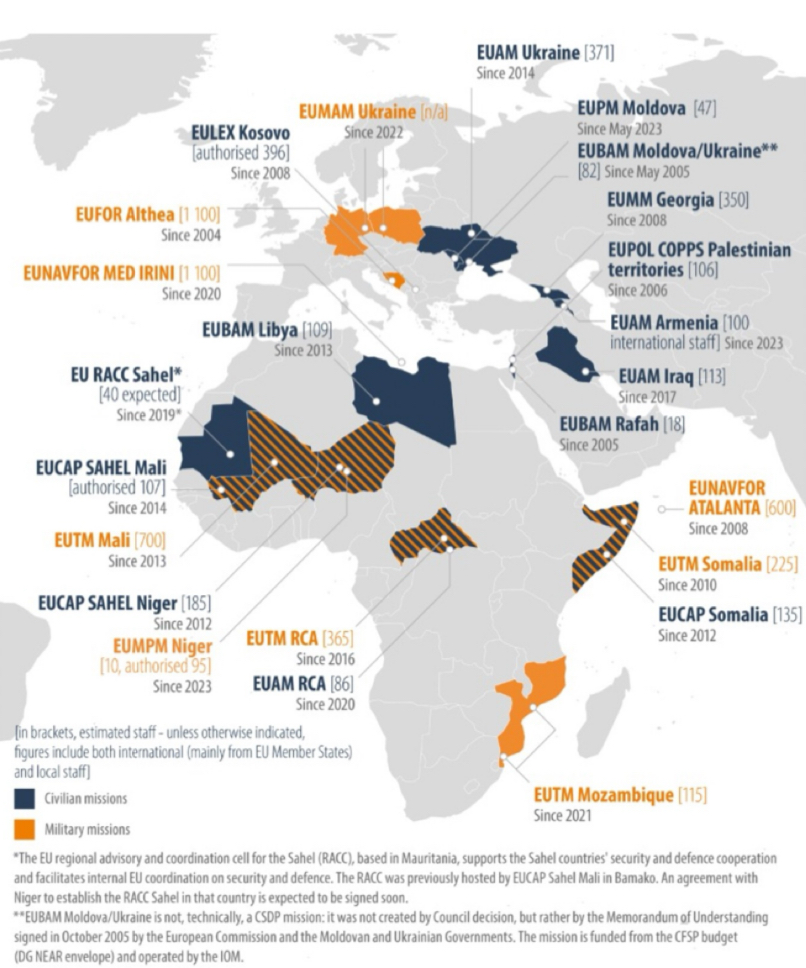
Permanent Structured Co-operation PESCO
June 2016: European Global Strategy (EGS)
Security and defense identified as one of five priorities
Art. 42 of Lisbon Treaty key (enhanced co-operation in defense)
June 2017: European Council agrees on “the need to launch an inclusive and ambitious Permanent Structured Cooperation”
Joint Notification on PESCO, FAC, 13 November 2017 (23 MS + later Portugal and Ireland)
11 December 2017: Formal decision establishing PESCO
PESCO
participation is voluntary, decision-making only by those participating
Each project managed by those members who contribute to it
PESCO secretariat within existing structures (EU budget)
Any participating state may propose projects to Secretariat:
EDA checks no duplication with existing projects EU/NATO
HRVP makes recommendations to the Council, which decides
Third-party states may be invited to participated if they bring ‘substantial added value’ but without decision-making rights
NOT an “EU-army”
Commitments of participating states of PESCO
regular increase in defense budgets
Increase defense capabilities to 20% if total defense spending
Increase spending on defense research and technology to 2% of total defense spending
Increase joint and collaborative projects
Harmonies capability requirements and prioritize a European collaborative approach
Collaborative PESCO projects + examples
Each project has a coordinator - a country that proposes the project
Each project has members - counties that decided to join in on the project
Examples
European Medical Command
Military Mobility
Energy Operational Functions (EOF)
Cyber threats and incident response information sharing platform
Indirect fire support
History: European Political Cooperation (EPC) After 70s
1970 really start of developing
Slow beginnings of the (formal) institutional setting
Important for member states to keep economic (EEC) and political cooperation (EPC) separate
One hand: those that favored intergovernmental cooperation worried that common institutions and they would come together into something supranational
On the other hand: those that favored supranational cooperation were worried that the merger might reverse the progress that had been made
France was the one that particularly insisted on this
Still today trade and foreign policy are not treated in the same way
1986: political cooperation written down in SEA
Legal basis and creates permanent EPC Secretariat in Brussels
“Procedure as substitute for Policy?”
History: example of how important it was to keep EEC and EPC separate for member states
Danish presidency in Council, US President Nixon coming to visit. He was there to meet with foreign ministers, but they did not meet in Brussels (too supranational) so they met in the capital of the country in presidency
Meet in the morning in Copenhagen (discuss points related to POLITICAL issues)
Afternoon travel to Brussels to discuss ECONOMIC issues (Trade)
EU decision-making in lens of International Relations
Delegation of power
EU outlier in this case —> Commission negotiates trade deals for all EU states
The power has been delegated but it has to be done on the mandate of the member states (final control)
Right of initiative
Within states: members of Parliament
EU: Commission
Member states stay in control bc they sit in the Council and the Commission has to come to them for approval (change it, kill it)
Pulling of sovereignty
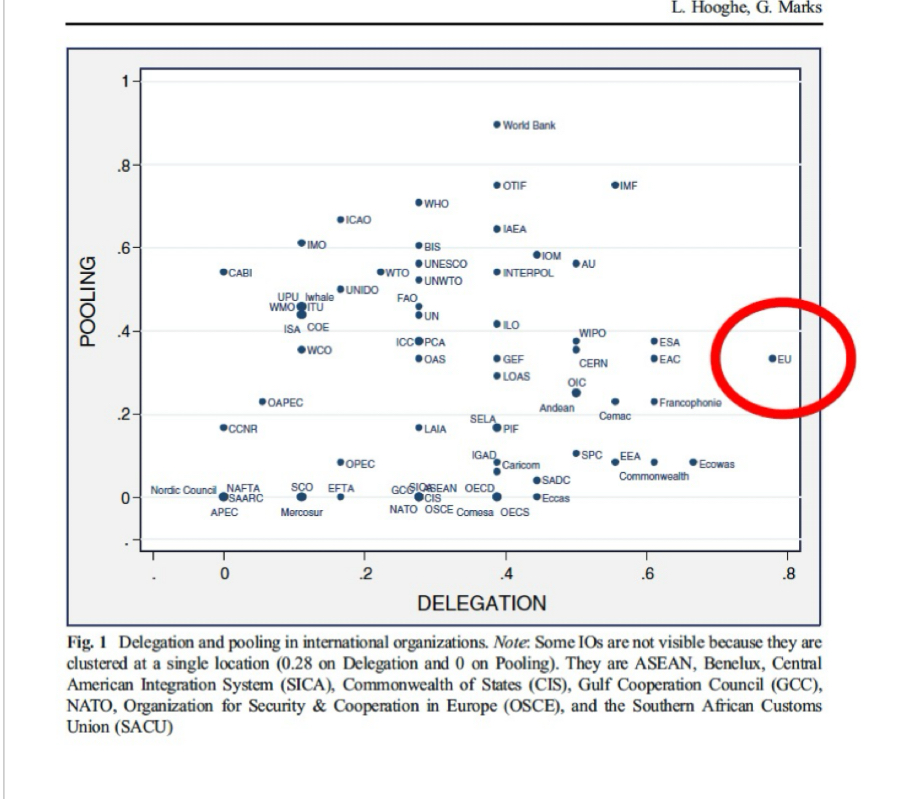
EU decision-making in lens of Comparative Politics
Commission: executive
Right of initiative —> strong
Can’t implement laws —> weak
Decision making
Council: represent member states
National executive
Brussels legislative (with EP)
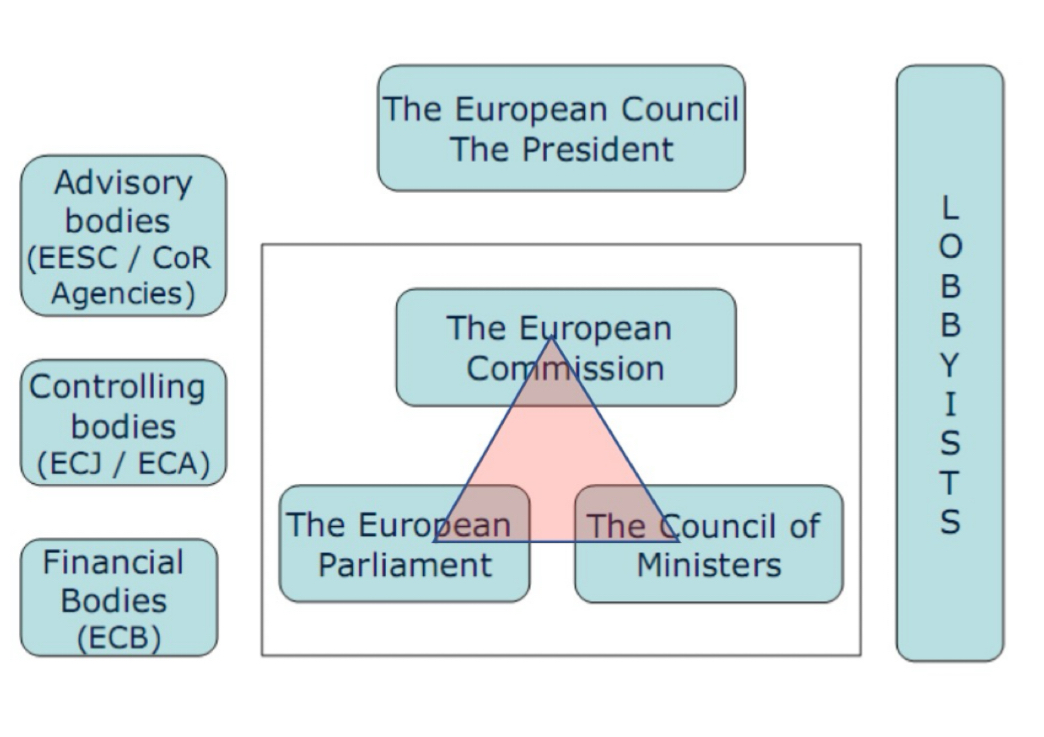
What type of decision-making is the focus?
Secondary legislation
What is secondary legislation decisions-making
Regulation, Directive Decisions
Ordinary legislative procedure (‘co-decision’) & special legislative procedures
Policy setting
Treaties tell us how secondary legislation is made
What is not within secondary legislation
Implementing legislation
Puts out what comes from secondary legislation into practice
EU competence within decision-making
Exclusive
Shared
Supportive
Exclusive Competences
Can only be taken at the EU level
Ex. Trade (member states can NOT have bilateral agreements with other nations)
Ex. Competition for internal market (common competition)

Shared Competences
Members can agree to have decisions made at EU level BUT in some areas it can take decisions at national level
Ex. Environment, climate change
If EU does not have legislation on it, member states are decide themselves how to deal with it
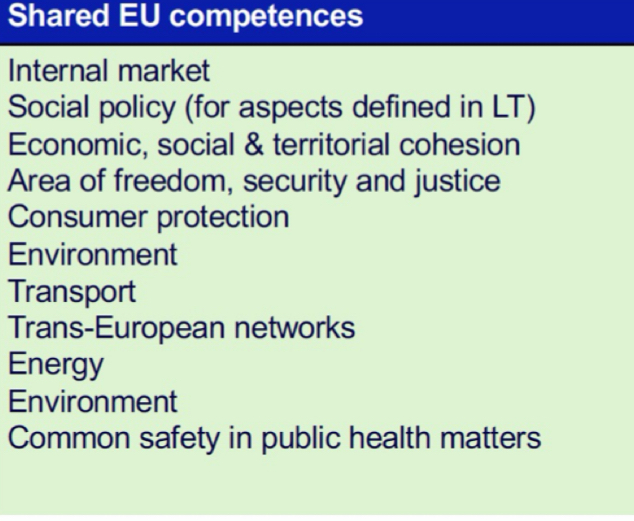
Supportive Competences
EU commission can gather member states in Brussels and they talk/exchange ideas —> end of the day they go back to their own nations and decide what to do
Commission can support member states in the discussion of ideas, no legislation is coming from it
Learn from each other, discuss ideas with each other
Might be the most effective way to make legislative
Why? Governments take ownership

Principle of Subsidiarity
Areas that do not fall under its exclusive competence, the Union shall only act as so far as the objectives of the proposed action cannot be sufficiently achieved by the member states, either at central, regional or local level. Those goals can be achieved at the EU level.
Are policy and decision making the same thing
No!
Policy making
Community method
Intensive transgovernmentalism mode
Member states are in charge —> make the most important decisions
Unless money is needed to be given -> commission needed (budget)
Commission is always in the room
Centralized decision-making: member states delegated the task to EU level
Competition policy
Eurozone interest rates
Open-method: similar to supported competences
Community method: policy making
commission proposes, European Parliament and the Council decide, Court adjudicates
Community method: decision-making
Commission proposes, EP and the Council decide, Court adjudicates
Community method: 4 decision-making procedures
Consultation procedure
Consent procedure
Cooperation procedure (not relevant)
Ordinary Legislative Procedure (aka co-decision)
What makes the different procedures within community methods different
The role of the EP
Consultation procedure
Within community method
Treaty of Rome
Council can:
Amend (change what is being proposed)
Veto (yes or no)
European Parliament can:
Amend (change what is being proposed)
Consent procedure
Within community method
Single European Act
Council can:
Amend (change what is being proposed)
Veto (yes or no)
European Parliament can:
Veto (yes or no)
Ordinary Legislative Procedure
Aka co-decision
Within community method
Maastricht Treaty (Lisbon Treaty)
Council can:
Amend (change what is being proposed)
Veto (yes or no)
European Parliament can:
Amend (change what is being proposed)
Veto (yes or no)
Ordinary Legislative Procedure: First reading
Commission comes up with proposal
Sends proposal to EU parliament and council + national governments for their opinions
First reading of EU - if it likes everything it can approve without amendment but can also add amendments to it if they are not satisfied (the Council then has to approve the amendments)
To approve them there is either QMV (if Commission also agrees with changes) OR with unanimity (if Commission does not agree with changes)
Council can also make amendments
Second reading of EP with Commission present

Ordinary Legislative Procedure: second reading
Second reading:
Do nothing —> act considered adopted
Like what the Council proposes and approves by simple majority
Really not like it —> veto
Not adopted
EP can included further amendments
Commission is asked for their opinion again
Goes to Council second reading
Can approve (QMV with Commission approval/ unanimity without Commission approval) —> act adopted
Doesn’t approve
Moves to third reading (if no agreement made)

Ordinary Legislative Procedure: third reading
Third reading = procedural deadlock
Conciliation committee is convened
There to find consensus
Made up of equal parts EP and the Council (27 each)
Commission is also represented —> the relevant Commissioner
Conciliation committee there to discuss any breakthroughs and find a way to agree on the text - formal procedure
Trialogues (informal): each representative from each delegation meet to clarify things, move things forward
Happens in parallel to conciliation committee
If both EP and Council within the Conciliation committee agree —> act adopted
If one does not agree —> not adopted
If no agreement can be reached at all —> not adopted
EP and the Council are present at every step of decision making
This means that representatives from every member state is present throughout —> can’t say ‘them in Brussels decided this’
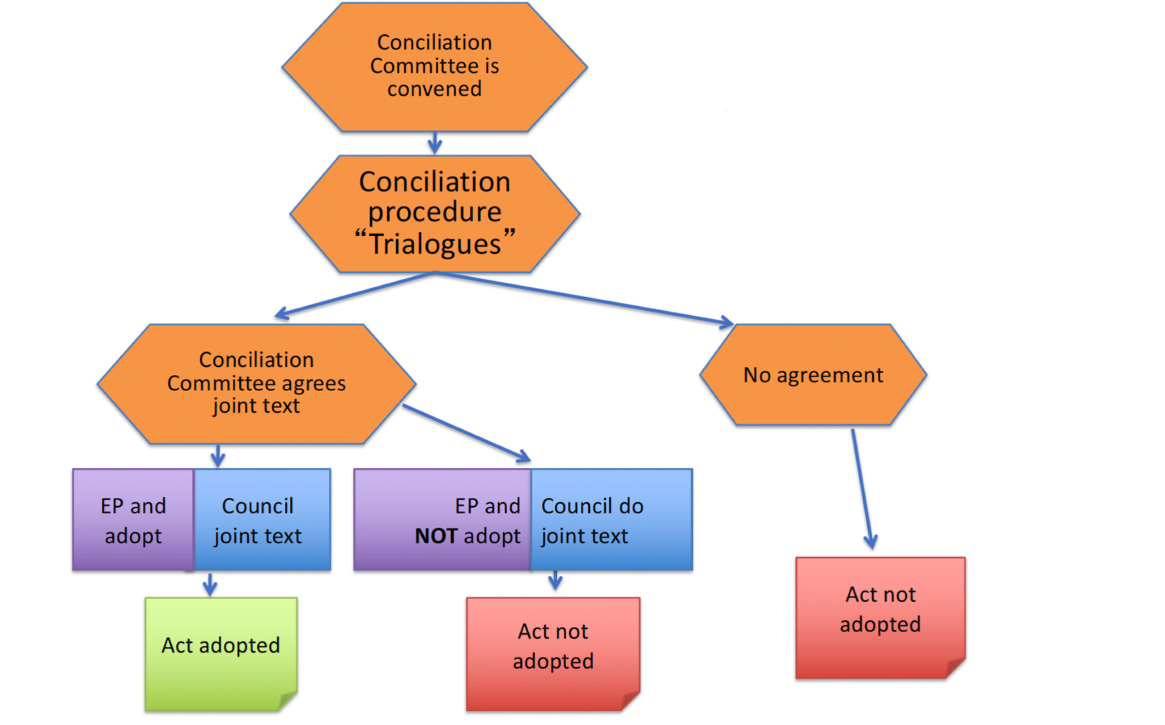
Simple majority
14 member states vote in favor
Qualified majority
55% of member states, representing at least 65% of the EU population, vote in favor
Unanimous vote
All votes are in favor
Council voting in reality
Mostly consensus
Even though QMV is the norm and what they are allowed to use 82% of the decisions are made by consensus
Culture of consensus in Council
don’t want to leave anyone behind, everyone on board
How the EP decides in the OLP
“Working parliament” → Committee with a rapporteur and a “shadow” rapporteur
Plenary
Simple majority in the first reading
Absolute majority later on
What is absolute majority in the EP
353 out of 705 votes
Average length of legislative process
Based on 2014 - 2016
First reading: 16 months
Second reading: 37 months
Third reading: -
Total average: 22 months
“Bang Goes the theory”

Problems with “Bang goes the theory ”
Lack transparency
Accountability (who is accountable?)
Odd one out in decision making
Foreign affairs
How are decisions made in foreign affairs
Agenda-setting/ policy proposals
High Representative/ EEAS
Member states - Council or European Council
Decision-making (no “laws”)
Unanimity in Council (“Decision”) & “constructive abstention”
For international agreements: consent of EP
Implementation
Programming decision by Commission/ EEAS
Member States
Trialogues: problematic?
not very transparent
More difficulties to exert democratic accountability
Old dilemma: efficiency vs transparency